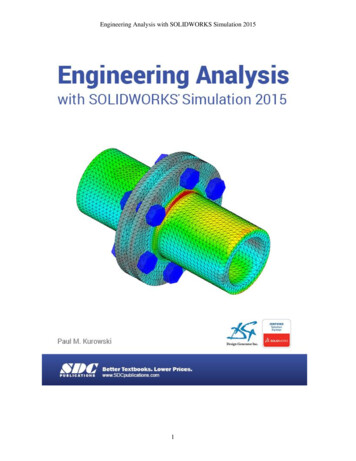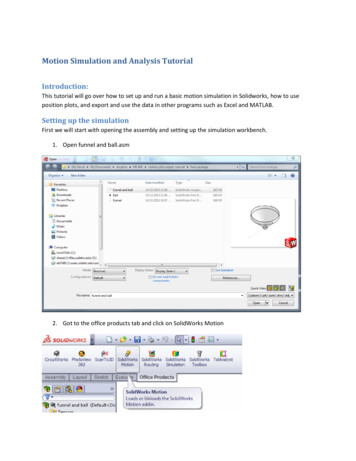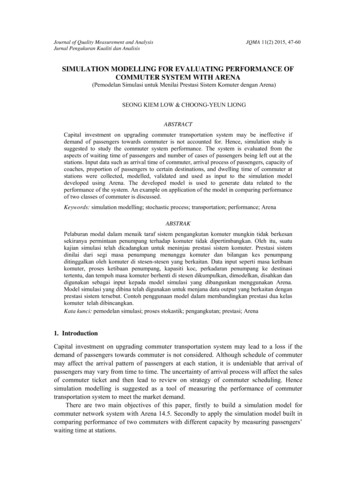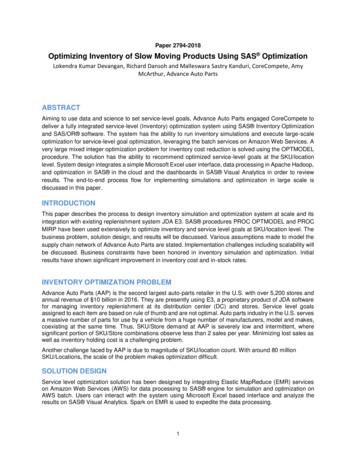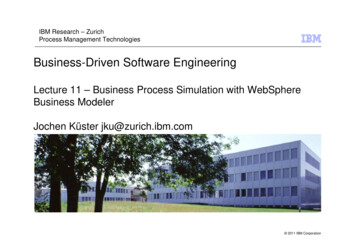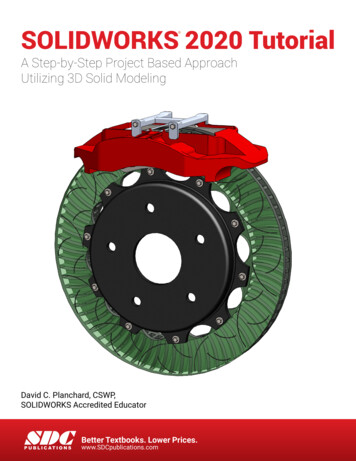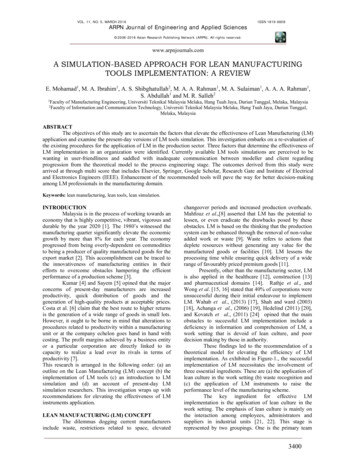
Transcription
VOL. 11, NO. 5, MARCH 2016ARPN Journal of Engineering and Applied SciencesISSN 1819-6608 2006-2016 Asian Research Publishing Network (ARPN). All rights reserved.www.arpnjournals.comA SIMULATION-BASED APPROACH FOR LEAN MANUFACTURINGTOOLS IMPLEMENTATION: A REVIEWE. Mohamad1, M. A. Ibrahim1, A. S. Shibghatullah2, M. A. A. Rahman1, M. A. Sulaiman1, A. A. A. Rahman1,S. Abdullah1 and M. R. Salleh21Faculty2Facultyof Manufacturing Engineering, Universiti Teknikal Malaysia Melaka, Hang Tuah Jaya, Durian Tunggal, Melaka, Malaysiaof Information and Communication Technology, Universiti Teknikal Malaysia Melaka, Hang Tuah Jaya, Durian Tunggal,Melaka, MalaysiaABSTRACTThe objectives of this study are to ascertain the factors that elevate the effectiveness of Lean Manufacturing (LM)application and examine the present-day versions of LM tools simulation. This investigation embarks on a re-evaluation ofthe existing procedures for the application of LM in the production sector. Three factors that determine the effectiveness ofLM implementation in an organization were identified. Currently available LM tools simulations are perceived to bewanting in user-friendliness and saddled with inadequate communication between modeller and client regardingprogression from the theoretical model to the process engineering stage. The outcomes derived from this study werearrived at through multi score that includes Elsevier, Springer, Google Scholar, Research Gate and Institute of Electricaland Electronics Engineers (IEEE). Enhancement of the recommended tools will pave the way for better decision-makingamong LM professionals in the manufacturing domain.Keywords: lean manufacturing, lean tools, lean simulation.INTRODUCTIONMalaysia is in the process of working towards aneconomy that is highly competitive, vibrant, vigorous anddurable by the year 2020 [1]. The 1980’s witnessed themanufacturing quarter significantly elevate the economicgrowth by more than 8% for each year. The economyprogressed from being overly-dependent on commoditiesto being a producer of quality manufactured goods for theexport market [2]. This accomplishment can be traced tothe innovativeness of manufacturing entities in theirefforts to overcome obstacles hampering the efficientperformance of a production scheme [3].Kumar [4] and Sayem [5] opined that the majorconcerns of present-day manufacturers are increasedproductivity, quick distribution of goods and thegeneration of high-quality products at acceptable prices.Costa et al. [6] claim that the best route to higher returnsis the generation of a wide range of goods in small lots.However, it ought to be borne in mind that alterations toprocedures related to productivity within a manufacturingunit or at the company echelon goes hand in hand withcosting. The profit margins achieved by a business entityor a particular corporation are directly linked to itscapacity to realize a lead over its rivals in terms ofproductivity [7].This research is arranged in the following order: (a) anoutline on the Lean Manufacturing (LM) concept (b) theimplementation of LM tools (c) an introduction to LMsimulation and (d) an account of present-day LMsimulation researchers. This investigation wraps up withrecommendations for elevating the effectiveness of LMinstruments application.LEAN MANUFACTURING (LM) CONCEPTThe dilemmas dogging current manufacturersinclude waste, restrictions related to space, elevatedchangeover periods and increased production overheads.Mahfouz et al.,[8] asserted that LM has the potential tolessen, or even eradicate the drawbacks posed by theseobstacles. LM is based on the thinking that the productionsystem can be enhanced through the removal of non-valueadded work or waste [9]. Waste refers to actions thatdeplete resources without generating any value for themanufactured goods or facilities [10]. LM lessens theprocessing time while ensuring quick delivery of a widerange of favourably priced premium goods [11].Presently, other than the manufacturing sector, LMis also applied in the healthcare [12], construction [13]and pharmaceutical domains [14]. Rathje et al., andWong et al. [15, 16] stated that 40% of corporations wereunsuccessful during their initial endeavour to implementLM. Wahab et al., (2013) [17], Shah and ward (2003)[18], Achanga et al., (2006) [19], Hedelind (2011) [20],and Kovatch et al., (2011) [24] opined that the mainobstacles to successful LM implementation include adeficiency in information and comprehension of LM, awork setting that is devoid of lean culture, and poordecision making by those in authority.These findings led to the recommendation of atheoretical model for elevating the efficiency of LMimplementation. As exhibited in Figure-1., the successfulimplementation of LM necessitates the involvement ofthree essential ingredients. These are (a) the application oflean culture in the work setting (b) waste recognition and(c) the application of LM instruments to raise theperformance level of the manufacturing scheme.The key ingredient for effective LMimplementation is the application of lean culture in thework setting. The emphasis of lean culture is mainly onthe interaction among employees, administrators andsuppliers in industrial units [21, 22]. This stage isrepresented by two groupings. One is the primary team3400
VOL. 11, NO. 5, MARCH 2016ARPN Journal of Engineering and Applied SciencesISSN 1819-6608 2006-2016 Asian Research Publishing Network (ARPN). All rights reserved.www.arpnjournals.comcomprising managers, engineers and human resources,while the other is the support team consisting oftechnicians, operators, drivers, clerks and cleaners [23].The fundamental concern here is the alteration in conductwithin the work setting. This includes a raised level ofdedication among those in authority, enhanced interactionbetween the primary and support teams [24], beinggrateful and considerate towards attempts to bolster theteam during problem-solving situations [25] and makingavailable accurate reports on all issues [24].Figure-1. Theoretical model of Lean ManufacturingThe successful implementation of lean culturethrough team effort clears the way for the next stage. Thisstage focuses on the recognition of waste in corporations.Seven frequently occurring waste circumstances wereidentified through the utilization of the LM concept.These include [26 - 28]; Overproduction: Generating more than therequirement of clients (ill-timed production). Linkedto ‘overproduction’ is ‘inventory’. This waste refersto the build-up of raw materials at ongoing worksites.Waiting: Delayed receipt of materials, components,machines, and instruments etc. which lead to adisruption in the chain of production.Unwarranted motion: Movements that do notcontribute to the enhancement of the quality of theproduct. These include substandard workflow,inferior layout, unsatisfactory housekeeping andunreliable or unrecorded work procedures.Transportation: The transference of any componentor material that does not straightforwardly improvethe quality of the product.Over-processing: This issue embraces reworking,deburring and checking.Defect: Production flaws and incompetent service.Subsequent to the recognition of waste, LM toolsare implemented to elevate productivity [28] through thelowering of expenditure, enhancing quality, lesseningflaws [29], trimming down lead times [27] and ensuringprompt delivery of products [30]. The fourteen leaninstruments available through the utilization of LM areValue Stream Mapping (VSM), Talk-Time, Kaizen, 5S,Jidoka, SMED, Poka-Yoke, Five-why, Standard work,Total Productive Maintenance (TPM), CellularManufacturing (CM), Heijunka, Just-In-Time (JIT) andKanban (Peter, 2009) [31]. Table-1 exhibits severalfavourable outcomes resulting from the utilization of LMtools.LEAN MANUFACTURING TOOLS SIMULATIONSimulation is employed as an instrument forelevating the efficiency of LM by imitating themanufacturing process without interrupting the chain ofproduction. This process works to provide a bettercomprehension of the system [43] and is frequentlyutilized for assessing innovative planning schemes,evaluating contemporary production procedures andeasing the way towards actual implementation of themanufacturing process [44 - 47]. The most significantattribute of simulation is its methodology in the context ofcosting as it allows for performance evaluation withoutactual implementation or disruptions to the chain ofproduction.Many simulation techniques have beendeveloped for the implementation of lean manufacturingtools. These include assembly electrical plug [48],hospital game [49], Lego game [50] and 5S game [51].These techniques can be categorized as off-line simulationas they are more inclined towards proactiveimplementation or well-established procedures. On theother hand, on-line simulation which is an amalgamationof simulation software and computer has developed intothe method of choice due to its effectiveness in designing,forecasting and implementing the system [47 - 51].Table-2 portrays recent studies and outcomes related tothe utilization of LM tools in an industrial setting.Nonetheless, present-day LM tools simulationtechniques are not easy to apply and are hampered by alack of communication between modeller and customerregarding information on progression from the theoreticalmodel to the process engineering phase [62, 63]. A furthersetback linked to these techniques is their inclinationtowards static simulation [64] instead of dynamicsimulation. Alzraiee et al (2013) [65] forwarded that thedevelopment of on-line simulation is confined to thedomain of specialists.3401
VOL. 11, NO. 5, MARCH 2016ARPN Journal of Engineering and Applied SciencesISSN 1819-6608 2006-2016 Asian Research Publishing Network (ARPN). All rights reserved.www.arpnjournals.comTable-1. Implementation of LM tools in industrial settings curtail reduction.CONCLUSIONS AND FUTURE WORKThis investigation recognized three essentialfactors for the successful implementation of LM tools.These are (a) the identification of waste in the productionchain (b) the application of lean tools in themanufacturing process and (c) the development of leansimulation. These factors come together to elevate theefficiency of lean implementation.Lean Tools Simulation (LeTS-2015) has beenrecommended for boosting usage and improving LPcomprehension. Comprising three lean tools, LeTS-2015can be utilized for assessing the production scheme andraising the capacity for good decision-making on the partof lean practitioners.The main interface of LeTS-2015 is illustrated inFigure-2. Three key LM tools (Kanban, CellularManufacturing and Single Minute of Exchange Die) wereopted for in this application. These tools were chosenbased on a survey conducted by Kovach et al., (2011)[24].ACKNOWLEDGEMENTSThe authors are grateful to the MalaysianGovernment and Universiti Teknikal Malaysia Melaka(UTeM) for funding this research via Grant(PJP/2014/FKP/ (9C)/S013262).3402
VOL. 11, NO. 5, MARCH 2016ARPN Journal of Engineering and Applied SciencesISSN 1819-6608 2006-2016 Asian Research Publishing Network (ARPN). All rights reserved.www.arpnjournals.comTable-2. Implementation of simulation lean manufacturing tools in an industrial setting.Key Performance Indicators (KPIs) At acturing Technology. Vol. 2 No.2, pp. 1-17.[4] Kumar, B.S. and S.S. Abuthakeer. 2012.Implementation of Lean Tool and Technique in anAutomotive Industry. Journal of Applied Sciences 12,pp. 1032-1037.[5] Sayem, A., M.A. Islam, M.M.A. Khan. 2014.Productivity enhancement through reduction ofchangeover time by implementing SMED technique –in furniture industry. Int. Journal Industries andSystem Eng. Vol. 17, No. 1.Figure-2. LeTS-2015 interface.REFERENCES[1] Bank Negara Malaysia (BNM), Annual Report 2013.http://www.bnm.gov.my [Accessed 19 Oct 2014].[6] Costa, E., S. Braganca, R. Sousa, A. Alves. 2013.Benefit from a SMED Application in a PunchingMachine. Int. Journal of Mechanical, IndustrialScience and Engineering. Vol. 7, No. 5.[2] Asid, R., 2010. The Technical Efficiency analyses ofManufacturing Sector in Malaysia: Evidence from thefirst Industrial Master Plan. Asian Social Science.Vol. 6, No. 2.[7] Bhat, R.R. and R.R. Shetty. 2013. Investigation ofLean Tools to Enhance Productivity inManufacturing Sector, Proceeding of 2nd Int.Conference on Emerging Trends in Engineering andManagement. Vol. 3, pp. 116-210.[3] Mohamad, E., Muhamamad M.R., Abdullah R. andA. Saptari. 2008. A study on The Development of[8] Mahfouz, A., J. Shea, A. Arisha. 2011. Simulationbased optimisation model for the lean assessment in3403
VOL. 11, NO. 5, MARCH 2016ARPN Journal of Engineering and Applied SciencesISSN 1819-6608 2006-2016 Asian Research Publishing Network (ARPN). All rights reserved.www.arpnjournals.comSME: a case study. Winter simulation conference2011, pp. 2408-2418.[9] Ghosh, M., 2013. Lean Manufacturing performancein Indian Manufacturing Plan. Journal ofManufacturing Tech Management. 24: 113-122.[10] Chowdary, B.V. and D. George. 2012. Improvementof manufacturing operations at a pharmaceuticalcompany. Journal of Tech Management. 23: 6-75.[11] Slack, N., Chamber, S. and Johnston, R. (2007)Operations Management. 5th ed., Prentice Hall, UK.[12] Buggy, J.M., and J. Nelson. 2005. Applying LeanProduction in Healthcare Facilities. Vol.6 No.5.Available at www.informedesign.umn.edu. [Access20 November 2014][13] Aziz, R.F., and S.M. Hafez. 2013. Applying t. Alexiandria Eng. Journal 52, pp.679695.[14] Ahmed, T., S.M. Ali, M.M. Allama, and M.S. Parvez.2010. A Total Productive Maintenance (TPM)Approach to Improve Production Efficiency andDevelopment of Loss Structure in a PharmaceuticalIndustry. Global Journal of Management andBusiness Research. 10: pp.186-190.[15] Rathje, M.S., Boyle, T.A. and P. Deflorin. 2009.Lean, take two! Reflections from the second attemptat lean implementation. Business Horizons, Vol. 52,No. 1, pp.79–88.[16] Wong, Y.C., Wong, K.Y. and A. Ali. 2009. A studyon lean manufacturing implementation in theMalaysian electrical and electronics industry.European Journal of Scientific Research, EuroJournals Publishing. Inc., Vol. 38, No. 4, pp. 521–535.[17] Wahab, A.N.A., M. Mukhtar, and R. Sulaiman. 2013.A Conceptual Model of Lean ManufacturingDimensions. The 4th Int. Conference on ElectricalEng. and Informatics. Procedia Technology 11:pp.1292-1298.[18] Shah, R., P.T. Ward. 2003. Lean Manufacturing:Context, Practice Bundles and Performance. Journalof Operation Management. 21: 129.[19] Achanga, P., Shehab, E., Roy, R. and G. Nelder.2006. Critical success factor for lean implementationwithin SMEs. Journal of Technology andManagement. Vol. 17, No. 4, pp. 460-71.[20] Hedelind, M., M. Jackson. 2011. How to improve theuse of robots in lean manufacturing systems. Journalof Manufacturing Tech Management. 22: 891-905.[21] Ghodrati, A., and N. Zulkifli. 2012. A review on 5SImplementation in Industrial and BusinessOrganizations. IOSR Journal of Business andManagement. 5: 11-13.[22] Pepper, M.P.J. and T.A. Spedding. 2010. TheEvolution of Lean Six Sigma. Int. Journal of Quality& Reliability Management. pp. 138-155.[23] Cooper, C. 2011. The Human Side of om/wp/wms human side.htm[Access 28 November 2014].[24] Kovach, J.V., E.A.Cudney, C.C. Elrod. 2011. The useof continuous improvement technique: A surveybased study of current practices. Int. Journal of Eng.,Science, and Technology. 3: 89-100.[25] Worley, J.M and T.L. Doolen. 2006. The role ofcommunication and management support in . 44: 228-245.[26] Chen, H., R. Taylor. 2009. Exploring the Impact ofLean Management on Innovation Capability.PICMET Proceeding. August 2-6, Portland, USA. pp.826-834.[27] Wahab, A.N.A., M. Mukhtar and R. Sulaiman. 2013.A Conceptual Model of Lean ManufacturingDimension. The 4th Int. Conference on Electrical Eng.and Informatics. Procedia Tech. 11: 1292-1298.[28] Abdulmalek, F.A., and J. Rajgopal. 2007. Analyzingthe benefits of lean manufacturing and value streammapping via simulation: A process sector case study.Int. J. Production Economic. 107: 223-236.[29] Pettersen, J. 2009. Defining lean production: someconceptual and practical issues. The TQM Journal.22: 238-142.[30] Ghosh, M. 2013. Lean Manufacturing Performance inIndia Manufacturing Plant. Journal of ManufacturingTechnology Management. 24: 113-122.[31] Peter L. King, 2009. Lean for the process industries,CRC Press. Business & Economics.[32] Ibrahim, M.A., E. Mohamad, M.H. Arzmi, M.A.A.Rahman, A. Saptari, A.S. Shibghatullah, M.A.Sulaiman, and M.A.M. Ali. 2015. Enhancingefficiency of die exchange process through singleminute of exchanging die at textile manufacturing3404
VOL. 11, NO. 5, MARCH 2016ARPN Journal of Engineering and Applied SciencesISSN 1819-6608 2006-2016 Asian Research Publishing Network (ARPN). All rights reserved.www.arpnjournals.comcompany in Malaysia. Journal of Applied Sciences15(3): 456-464.[33] Mulla, M.L., S.G. Bhatwadekar and S.V. Pandit.2014. Implementation of Lean ManufacturingThrough the Technique of Single Minute Exchangeof Die (SMED) to Reduce Change over Time. Int.Journal of Innovative Research in Science, Eng. andTech. pp. 13069-13076.[34] Singh, R., A.M.Gohil, D.B. Shah and S. Desai. 2013.TotalProductiveMaintenance(TPM)Implementation in a Machine Shop: A Case Study.Chemical, Civil and Mechanical Eng. Tracks of 3rdNirma University Int. Conference on Eng., ProcediaEng. 51: 592-599.[35] Kurunesh G. and C. Thotappa. 2013. Lead TimeReduction in Order Execution of Horizontal SlurryPumps Using Lean Concepts for Mining EquipmentsManufacturing Company. Int. Journal of Scientific &Eng. Research. 4: 1-15.[36] Naufal, A., A. Jaffar. N. Yusoff and N. Hayati. 2012.Development of Kanban System at LocalManufacturing Company in Malaysia – Case Study.Int. Symposium on Robotics and Intelligent Sensors.Procedia Eng. 41: 1721 – 1726.[37] Bhat, R.R., and S. Shivekumar. 2011. Improving theProductivity using Value Stream Mapping andKanban Approach. Int. Journal of Scientific & Eng.Research. 2: 1-5.[38] Pan, G., D. Feng, and M. Jiang. 2010. Applicationresearch of shortening delivery time through valuestream mapping analysis. Industrial Eng. and Eng.Management 17th Int. Conference. pp. 733-736.[39] Mujtaba, S., R. Feldt, K. Petersen. 2010. Waste andLead Time Reduction in a Software ProductCustomization Process with Value Stream Maps.IEEE 21st Australian Software Eng. Conference. pp.139-148.[40] Yang, L. and X. Zhang. 2008. A Research on theApplication and Effect of the Value rers - A Case Study of Midea. Int.Colloquium on Computing, Communication, Control,and Management. pp. 314-318.[41] Carr, J.M. 2005. Value Stream of a Rubber, ProductManufacturer. University of Wisconsin-Stout.[42] Singh, B., S. Garg, and S. Sharma. 2011. ValueStream Mapping: Literature Review and Implicationsfor Indian Industries. Int. Journal of AdvancedManufacturing Technology. pp. 799-805.[43] Venkat. K. and W.W. Wakeland, 2006. Usingsimulation to understanding and optimize a leanservice process. Simulation Siries. 38(2): 242.[44] Gadre, A., E. Cudney, and S. Corns. 2011. ModelDevelopment of a Virtual Environment to EnhanceLean Education. Proceedia Computer Science 6,Elsevier. pp. 100-105.[45] Mohamad, E., T. Ito, and D. Yuniawan. 2013. Asimulation-based approach to decision support forlean practitioners. 20th ISPE Int. Conf. on ConcurrentEng. IOS Press. pp. 274-283.[46] Detty, R.B., and J.C. Yingling. 2000. Quantifyingbenefits of conversion to lean manufacturing withdiscrete even simulation: a case study. Int. J. Prod.Res. 38: 429-445.[47] Zee, D.V.D. 2012. An Integrated ConceptualModeling Framework For Simulation – LinkingSimulation Modeling To The Systems Eng. Process.Winter Simulation Conference 2012. pp. 1-12.[48] Silva, I. D., A.R. Xambre, and R. B. Lopes, 2013. Asimulation game framework for teaching leanproduction. International Journal of IndustrialEngineering and Management (IJIEM), Vol. 4 No. 2,pp. 81 – 86.[49] Popovska, D., Iskra, V. Hove-Madsen, and KarlBrian Nielsen, 2008. Teaching lean thinking throughgame: Some challenges. 36th European Society forEngineering Education (SEFI) on QualityAssessment, Employability & Innovation.[50] Gonzalez, V. A., B. Senior, F. Orozco, L. F. Alarcon,J. Ingle and A. Best, 2014. Simulation leanproduction principle in construction: A last plannerdriven game. Proceeding IGLC-22, Osl, Norway.[51] Gomes, D.F., M.P. Lopes, and C. V. de Carvalho,2013. Serious game for lean manufacturing: the 5Sgame. Tecnologias del Aprendizaje, IEEE RevistaIberoamericana de. Vol. 8, No. 4.[52] Visakh, Mj, and S. Aravind. 2014. OptimizationUsing Simulation Design of Experiments and ValueStream Mapping. Int. Journal of Design andManufacturing Technology. pp. 194-203.[53] Senthiiland, P.V. and A. Shirrushti. 2014.Productivity enhancement with lean concepts in beltdriven compressor industry. Int. Journal of Recentadvances in multidisciplinary research. Vol. 1, No.3,pp. 51-55.[54] Anbumalar, V., and R. Mayandy, K.A. Prasath,M.R.C. Sekar. 2014. Implementation of Cellular3405
VOL. 11, NO. 5, MARCH 2016ARPN Journal of Engineering and Applied SciencesISSN 1819-6608 2006-2016 Asian Research Publishing Network (ARPN). All rights reserved.www.arpnjournals.comManufacturing in Process Industry-A Case Study. Int.Journal of Innovative Research in Science, Eng., andTech. pp.1144-1149.[55] Mohamad, E. and T. Ito. 2013a. Integration of elearning and simulation to user training programmeof SMED. Int. J. Internet Manufacturing andServices, Vol. 3, No. 2.[56] Mohamad et al. 2013b. Quantifying benefits of leanmanufacturing tools implementation with simulationin coolant hose factory. Journal of Human CapitalDevelopment. Vol.6, No.2.[57] Ruikar, N. V., and M.T. Telsang, Modeling andSimulation of Manufacturing Performances usingWITNESS. IOSR Journal of Mechanical and CivilEng. pp. 2278-1684.[58] Lemessi, M., S. Rehbein, G. Rehn, and T. Schulze.2012. Semi-Automatic Simulation-Based BottleneckDetection Approach. Proceedings of the 2012 WinterSimulation Conference. pp. 1-12.[59] Mohamad, E. and T. Ito.2012. Development of asimulation-based SMED training system. Proceedingof first Int. symposium on socially and technicallysymbiotic system, Okayama, Japan. August 29-31.[60] Khafaji, S.K.H. and H.M.R. Rufaifi. 2012. A casestudy of production improvement by using lean withsimulation modelling. Proceeding of the 2012 Int.conference on industrial Eng. and operationmanagement Istanbul. Turkey, July 3-6.[61] Ito, T. and E. Mohamad. 2010. Simulation studytowards productivity improvement in Manufacturing.JSME, Tokushima Conference. p. 125.[62] Zee, D.V.D. 2012. An Integrated ConceptualModeling Framework for Simulation – LinkingSimulation Modeling To The Systems Eng. Process.Winter Simulation Conference.pp. 1-12.[63] Willams, E.J. and 0.M. Ulgen. 2012. Pitfalls inmanaging a simulation project. Proceeding of the2012 simulation conference. pp. 1-8.[64] Khafaji, S.K.H. and H.M.R. Rufaifi. 2012. A casestudy of production improvement by using lean withsimulation modelling. Proceeding of the 2012 Int.conference on industri al Eng. and operationmanagement Istanbul. Turkey, July 3-6.[65] Alzraiee H., T. Zayed and O. Moselhi, 2013.Assesment of constructions productivity rate ascomputed by simulation models.Winter SimulationConference. pp. 3225-3236.3406
Keywords: lean manufacturing, lean tools, lean simulation. INTRODUCTION Malaysia is in the process of working towards an economy that is highly competitive, vibrant, vigorous and durable by the year 2





